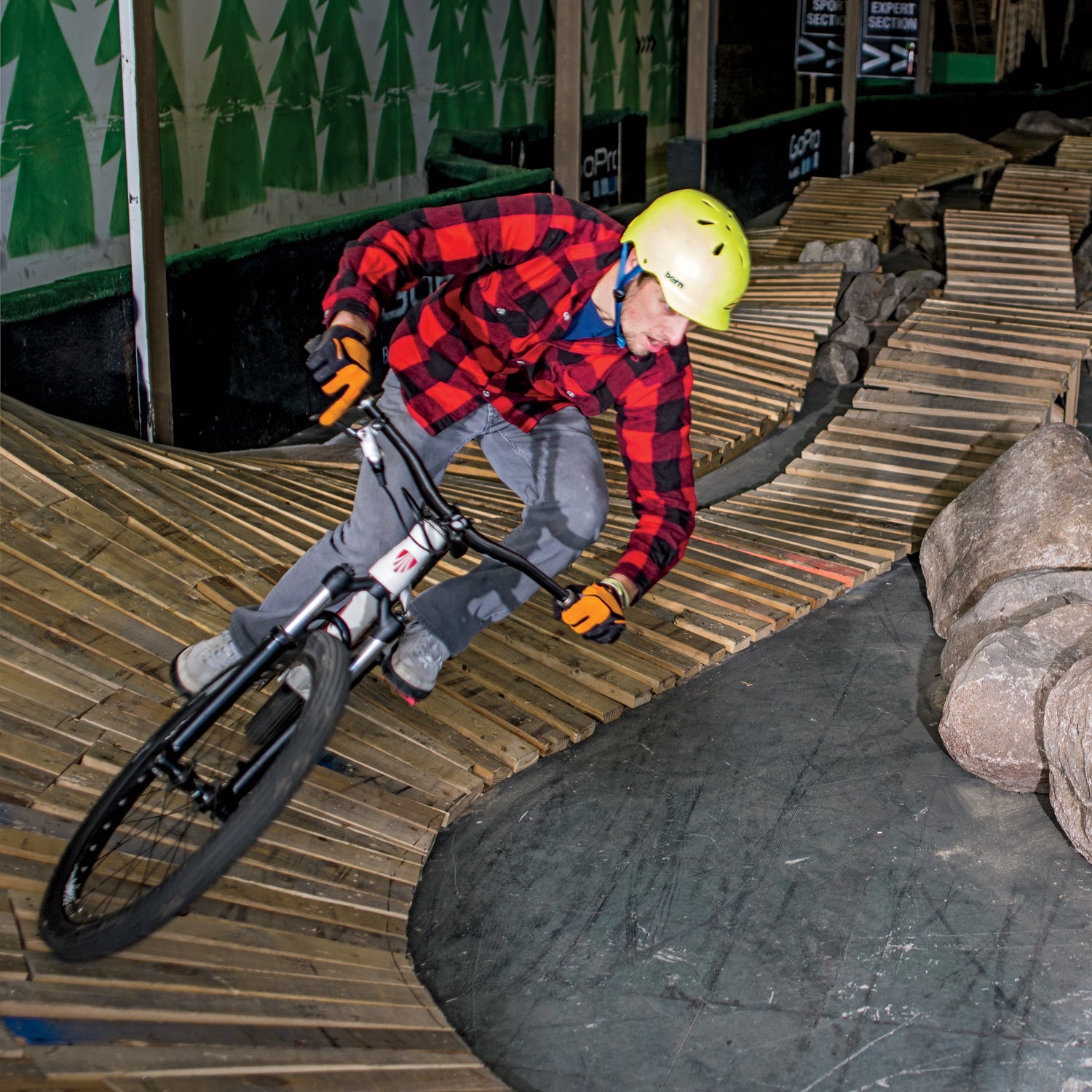Seventy-five feet under the Louisville Zoo, in a labyrinth of Kentucky limestone mined into Swiss cheese, a few million pounds of soil have been sculpted into the trails, berms, and jumps at , the world’s first underground bike park. When it opens to the public in February, the park will have more than five miles of interconnected trails that range from flowing singletrack to dirt jumps to technical lines with three-foot drops. And that’s just the first of three phases to roll out this winter.
Mega Cavern may be the premier subterranean playground for mountain bikers, but it’s part of a much larger trend of urban bike parks. “There are so many in development right now, it’s hard to keep track of them,” says Mark Eller, communications director at the , which has seen requests for advice on parks double over the past few years. “There’s an established shift toward purpose-built trail construction.”
The first urban parks popped up in less than desirable real estate, like , an elevated stretch of I-5. In the years since, they’ve only gotten bigger and better—and more beginner-friendly. In the same way that terrain parks at ski resorts are carefully calibrated, the most popular urban bike venues allow new riders to progress and build new skills, moving from baby-bear rollers to mama-bear tabletops to papa-bear gap jumps. There are now some 100 urban bike parks across the country, everywhere from Boulder, Colorado, to Chicago. And the most recent trend is to move them indoors.
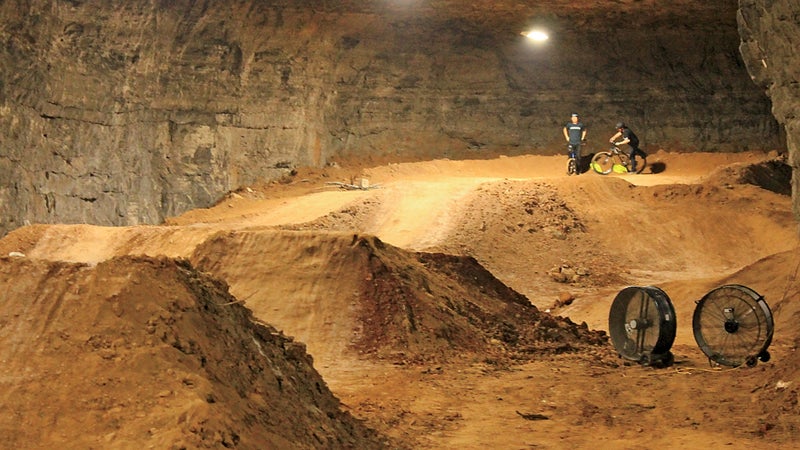
In 2004, driven by the desire to ride year-round, a carpenter named Ray Petro spent four months converting a 130,000-square-foot former rayon factory in Cleveland into the first indoor park in the country. The result, , was a vast playground filled with ramps, jumps, and roller-coaster-like pump tracks. “I wanted to make guys who are 30 feel like they’re 15 for a few hours a week,” says Petro.
It worked. Ray’s was so successful that Petro opened a second location in Milwaukee in 2010, with its own street park, pump track, foam pit, and VIP lounge. Soon other frigid locales like Toronto, Pittsburgh, and Syracuse, New York, had indoor parks, too.
While many of these parks are impressive, none are as big or ambitious as the aptly named Mega Cavern. By the time the third phase is completed, there will be 40 sections of dirt, a kids-only skills area, gravity trails, and a massive jump room. “It’s about three times the size of anything that’s indoors right now,” says Mega Cavern designer , a carpenter who honed his craft at Ray’s and is now one of the country’s most sought-after bike-park builders and architects. When Prisel is finished, the Mega Cavern will look like something from a Danny MacAskill fever dream, with intricate loops of singletrack punctuated by ladder bridges over giant rocks and, where paths intersect, tunnels and overpasses made from shipping containers. “It’s more than an indoor jump park,” says Prisel. “It’s an indoor trail system.”
In early January, one month before the park was scheduled to open, Prisel was in the cavern, fine-tuning the dirt jumps. I met him underground to talk about the logistics of designing and crafting the park. The following are excerpts from the interview, edited for length and clarity.
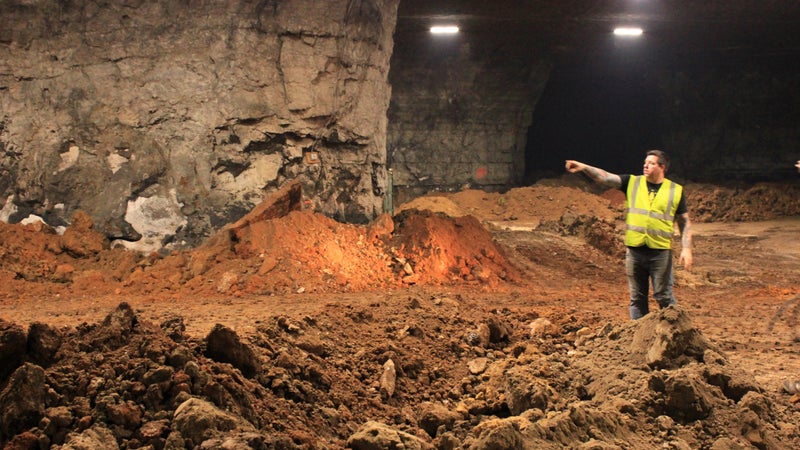
OUTSIDE: This place is massive. How did you get your head around a space this vast? How do you even start to conceptualize how to use it?
PRISEL: This didn’t feel like building an indoor park. It felt like building an outdoor park, and it’s actually small compared to a lot of the outdoor parks that I’ve built. But it was easy to get turned around in the cavern when nothing was in it. Those first couple weeks, when we were starting to map stuff out, it felt like it was going to take a year to do it. But it actually went pretty fast.
How long did it take to build the whole course? And how much manpower did you have?
It was mostly me and Jeff (Perkins) and three machines—a skid steer, a mini excavator, and a 950 loader. This is our 71st day. And we’re almost done. We had some volunteers, but we mostly wanted them to ride the trails and buff them out.
This whole project sounds like a trail builder’s wet dream. Unlimited space. Unlimited resources. No micromanagement. The owners trusted you and pretty much turned you loose. What was that like?
Frustrating. I wanted to do so many crazy things, but I had to slow myself down. First we had to get a cross-country trail around the perimeter. Then we had to dedicate space to dirt jumps, flow trails, and technical trails. It became a giant mathematical equation of walking stuff out every day, mapping it out, saying, wait a minute, this is lining up a little different, so lets go back and map it out again.
Let’s talk dirt. You have “craft” dirt at your park in Burlington. But here, dirt has been a big challenge. Can you talk about where the dirt comes from, how much has been trucked in, and the different types of dirt you have to work with?
This has been the craziest dirt I have ever worked with. Mega Cavern is also an environmental recycling company where construction companies come and dump all kinds of dirt. You see a big pile where someone is building a new driveway, so you have chunks of cement in with topsoil and gravel. You have someone who is digging up their lawn to build a pond or a swimming pool, and it’s really good topsoil, a little bit of grass, and some really good clay. Then you’ll have the really dusty, fine riverbed silt that they’re pulling out from building bridges in Louisville. And then you have people trucking in this really crazy sticky red clay from down South. We sort it into five different piles. We start the trail off and use the rough stuff. And we add the red sticky clay, and that hardens. And then we use the really good stuff. In a sense, we’re building the trail three times. But that’s okay, because it’s working really well.
[quote]“You have your little cycling niches, and they get along, but they don’t always mix well. This bike park is kind of like a blender.”[/quote]
What’s so special about your dirt at Burlington Bike Park?
It’s BMX track dirt. Something like 95 percent clay, 5 percent sand.��
There’s a formula?
There’s a formula. They won’t tell it to us. We bought it from .
How much does that dirt cost?
Um, a lot.��
You have built a lot of different bike parks, and you did a lot of building early on at Ray’s MTB Park in Milwaukee, which was the first one. His parks have a lot of wood. At Mega Cavern, it’s almost exclusively dirt, with the exception of the containers and a couple of wooden features. Can you talk about why you decided not to use more wood?
We’re in the process right now of adding wood on connecting routes. But not on main routes where people are going fast. A lot of the wood features are really tight, slow-turning things, the technical stuff. There will be some of that, but not as much as Ray’s Mountain Bike Park, which is primarily all stuff like that. Ray has done a great job of figuring out how to pack a lot into his space. Mega Cavern is so big that we don’t need to pack all the skinnies real tight and close to one another. We can spread them out, and actually have more setup time for them. At places like Ray’s and other indoor parks, you session it. This is a different mindset. You come to ride it like a trail. You don’t come here to sit in one spot and session it.
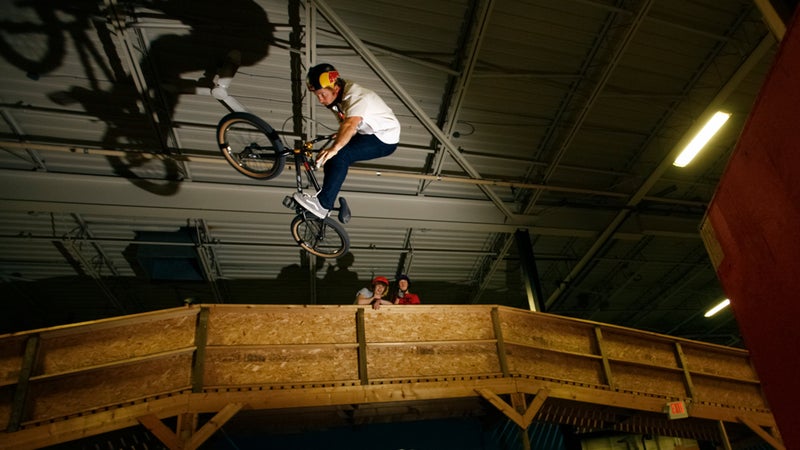
What are some of the advantages and disadvantages of building tracks with wood versus dirt?
Dirt, you can tear it down and change it in a day, and it doesn’t cost you anything. With wood, every time you tear it down you lose some of the wood, so you have to buy more wood, buy more screws and nails. Dirt is very cost effective. At my park in Burlington, we’ve been open one year and I’ve changed the park 4 times already.
This is a legitimate bike park by connoisseurs’ standards. But it’s tucked in this mainstream tourist attraction. How is this going to work?
This place is going to attract every one along the whole spectrum of riders—mountain bikers, BMX riders, cross-country guys and dirt jumpers. You have your little cycling niches, and they get along, but they don’t always mix well. This bike park is kind of like a blender. We’re mixing everybody into a family environment, a learning environment, an extremely fun environment. Because it’s in close quarters, it’s going to create friendships, bonds between people who don’t normally interact. Once you start building those relationships, getting people so excited to be around other people, in such a cool place, that’s going to build mountain biking, indoors and out.
You’ve got a two-year-old son who is already shredding on a push bike. Has that changed your perspective on trail design?
I had to figure out, how do you build a trail that can have every single level on it, going the same direction? The perimeter loop has three trails running next to each other, for different levels. The outside loop is really smooth. The middle loop has more rollers and berms. The inside line is more difficult, so if a good rider is riding that harder line and hammering, it twists and turns and has enough features that someone on the green line will be going the same pace. The faster rider won’t get too far ahead of his family. So you can ride every level with your family, in the same area, and never lose sight of them. They can watch you, and you can watch them.
Brilliant. Have you incorporated family riding into any of your other designs?
No. And the first design was not like that. But I wanted to focus on the families and the kids. I can go to Whistler and ride, but I can’t take my wife and kid on the trails that I’m gonna ride. So I just spent a vacation not hanging out with my family. I have fun and they get mad. Or they have fun and I get mad. It doesn’t work. But this is where mountain biking is going—whole families are doing it. You have 7-year-old kids, 15-year-old kids, 2-year-old kids, all riding with mom and dad. Dad’s riding a 6-inch travel DH bike. Mom’s riding a cross-country bike. Kids are riding whatever they can piece together to have fun.
A Quick Guide to the Nation’s Indoor Parks
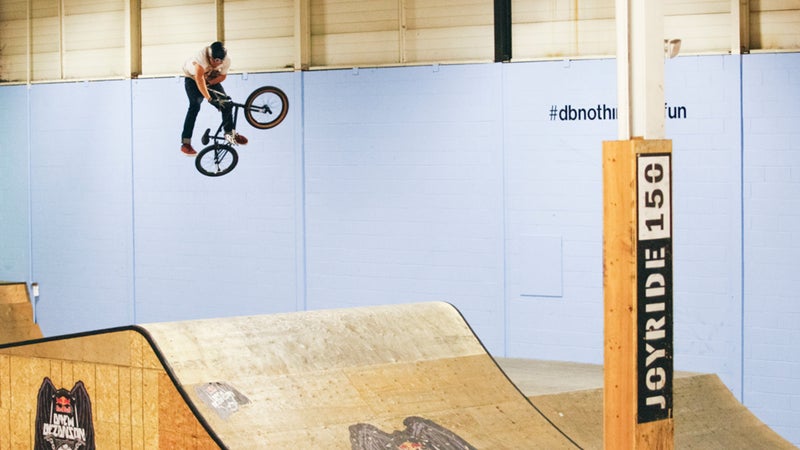
(Burlington, Washington)
Racetrack-quality dirt, 40,000 square feet.
(Syracuse, New York)
Supersize jumps, vert walls, outdoor jump line.
(Toronto)
Kids’ programs, concessions, progressively harder rooms.
(Portland, Oregon)
Jump line, on-site pub, 40,000 square feet.
(Louisville, Kentucky)
More than 40 trails, 320,000 square feet, dirt jump room.
(Cleveland)
The original, and still one of the best, with 130,000 square feet of space to play in.
(Milwaukee)
Supertight wooden pump track, foam pit for inverts.
(Pittsburgh)
Two stories, 80,000 square feet, built with reclaimed lumber.


